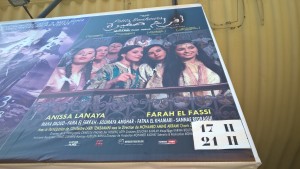As Florence wrote in her blog on the death of the father in recent Moroccan films (15 March), Petits Bonheurs by Mohamed Chrif Tribak starts immediately after the death of a father and looks at the consequences for a poor widow Zineb and her seventeen-year-old daughter Nouffissa. However, the film does not reflect on this bereavement, and pragmatically looks forward at the future and dreams of a teenager in 1955 Morocco. In hindsight of course this is appropriate, as Morocco is about to gain independence, and the role of women is about to change dramatically. That this film focuses so singularly on women’s lives and roles, shows a turn in Moroccan cinema (even by men) towards the female sphere. I read a few similarities with some Tunisian films into this film.

As a widow unable to meet her and her daughter’s basic needs, Nouffissa’s mother is forced to accept the invitation from Lalla Amina, a wealthy woman, to settle at her large home. There is a suggestion that Amina and Zineb were “more than just friends” in the past. The film deals with girls’ education, domestic roles and appropriate dress sense. Within this large house in the medina of Tetouan, an ambiguous friendship parallel to Zineb and Lalla Amina’s develops between Nouffissa and Fetouma, granddaughter of Lalla Amina.
Perhaps the most interesting sequence is the group of women’s excitement about a new film with a famous, handsome actor, and their attendance at the cinema of this Egyptian melodrama. In the film, emotions run much higher than they do in Petits Bonheurs itself, but the experience of going to the cinema is a reason for excitement. The girls recall that just a few years ago they were hardly allowed to go outside. It is, as a matter of fact, Nouffissa’s first time at the cinema, and she looks in bewilderment at the screen, but also at the ‘rencontres’ between girls and boys around her. It makes her innocent outlook on love and marriage all the more endearing.
The two girls, both living under pressure of tradition moving into modernity, have divergent views. While Nouffissa does not wear the veil and Fetouma does, Fetouma embodies the rebellious girl, who rejects the idea of early marriage and hopes to continue her studies, while Nouffissa would like to find a husband as she aspires upward social mobility. In this way, the film shows some parallels with Tunisian Nouri Bouzid’s Hidden Beauties (2012). Their relationship comes under pressure when Fetouma confesses she has had sex but is not interested in marriage, while Nouffissa hides from Fetouma her engagement to someone she does not know.
With exquisite detail, the film showcases the architectural, decorative and fashion trends of the 50s and 60. It also looks at both the modern and traditional styles and modes of thinking by women, and shows the power of the static camera and the reflexive, slow development of a simple, straightforward story. Careful with the male gaze, the camera and the director manage to remain unobtrusive fairly successfully, except when Fetouma acts on an instinctual and naïve act of lust on the impressionable Nouffissa.

The film offers a calm balance and a sense of peace with fate. While it does not totally eschew political or feminist rhetoric, it also does not foreground it. With this comes a certain risk taken by the director: the film shows some similarities with Tunisian Moufida Tlatli’s The Silence of the Palace (1994), but where Tlatli’s film is outspoken about women’s voices being drowned out by men and the uncertainties independence brings for North Africa, Petits Bonheurs seems more interested in a happy ending (see the title of the film, indicating little pleasures). I suspect this is where its accessibility lies, and its success with large local audiences. Garnering standing ovations and winning important prizes on the festival circuit inside Morocco, and being screened at the large multiplexes as well as the more discerning cinemas to large audiences, is proof of this film’s subtle yet permissible look into the past of Moroccan women. It is precisely the subtlety with which it acts that attracts a large female crowd to the cinema.